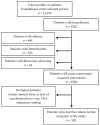Can Lung Ultrasound Act as a Diagnosis and Monitoring Tool in Children with Community Acquired Pneumonia? Correlation with Risk Factors, Clinical Indicators and Biologic Results
- PMID: 40806926
- PMCID: PMC12347390
- DOI: 10.3390/jcm14155304
Can Lung Ultrasound Act as a Diagnosis and Monitoring Tool in Children with Community Acquired Pneumonia? Correlation with Risk Factors, Clinical Indicators and Biologic Results
Abstract
Background: Community-acquired pneumonia (CAP) is the leading cause of mortality in children from middle- to low-income countries; diagnosing CAP includes clinical evaluation, laboratory testing and pulmonary imaging. Lung ultrasound (LUS) is a sensitive, accessible, non-invasive, non-radiant method for accurately evaluating the lung involvement in acute diseases. Whether LUS findings can be correlated with CAP's severity or sepsis risk remains debatable. This study aimed to increase the importance of LUS in diagnosing and monitoring CAP. We analyzed 102 children aged 1 month up to 18 years, hospital admitted with CAP. Mean age was 5.71 ± 4.85 years. Underweight was encountered in 44.11% of children, especially below 5 years, while overweight was encountered in 11.36% of older children and adolescents. Patients with CAP presented with fever (79.41%), cough (97.05%), tachypnea (18.62%), respiratory failure symptoms (20.58%), chest pain (12.74%) or poor feeding. Despite the fact that 21.56% had clinically occult CAP and six patients (5.88%) experienced radiologically occult pneumonia, CAP diagnosis was established based on anomalies detected using LUS. Conclusions: Detailed clinical examination with abnormal/modified breath sounds and/or tachypnea is suggestive of acute pneumonia. LUS is a sensitive diagnostic tool. A future perspective of including LUS in the diagnosis algorithm of CAP should be taken into consideration.
Keywords: children; community-acquired pneumonia; lung ultrasound.
Conflict of interest statement
The authors declare no conflicts of interest.
Figures





Similar articles
-
Prescription of Controlled Substances: Benefits and Risks.2025 Jul 6. In: StatPearls [Internet]. Treasure Island (FL): StatPearls Publishing; 2025 Jan–. 2025 Jul 6. In: StatPearls [Internet]. Treasure Island (FL): StatPearls Publishing; 2025 Jan–. PMID: 30726003 Free Books & Documents.
-
Signs and symptoms to determine if a patient presenting in primary care or hospital outpatient settings has COVID-19.Cochrane Database Syst Rev. 2022 May 20;5(5):CD013665. doi: 10.1002/14651858.CD013665.pub3. Cochrane Database Syst Rev. 2022. PMID: 35593186 Free PMC article.
-
[Guidelines for the prevention and management of bronchial asthma (2024 edition)].Zhonghua Jie He He Hu Xi Za Zhi. 2025 Mar 12;48(3):208-248. doi: 10.3760/cma.j.cn112147-20241013-00601. Zhonghua Jie He He Hu Xi Za Zhi. 2025. PMID: 40050074 Chinese.
-
Clinical symptoms and signs for the diagnosis of Mycoplasma pneumoniae in children and adolescents with community-acquired pneumonia.Cochrane Database Syst Rev. 2012 Oct 17;10(10):CD009175. doi: 10.1002/14651858.CD009175.pub2. Cochrane Database Syst Rev. 2012. PMID: 23076954 Free PMC article.
-
Antibiotics for community-acquired pneumonia in adult outpatients.Cochrane Database Syst Rev. 2014 Oct 9;2014(10):CD002109. doi: 10.1002/14651858.CD002109.pub4. Cochrane Database Syst Rev. 2014. PMID: 25300166 Free PMC article.
References
-
- Plesca D.A. Tratat de Pediatrie. Medichub; Bucharest, Romania: 2021. Community acquired pneumonia; pp. 339–347.
LinkOut - more resources
Full Text Sources
Miscellaneous

